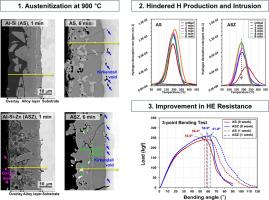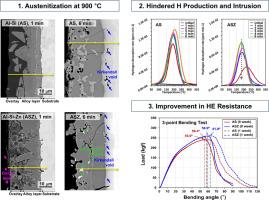Enhancing resistance to hydrogen embrittlement in high-strength hot-press-forming steel sheets through Al-Si-Zn coating optimization
IF 8.3
1区 材料科学
Q1 MATERIALS SCIENCE, MULTIDISCIPLINARY
引用次数: 0
Abstract
This study addresses critical issues of hydrogen embrittlement (HE) and liquid metal embrittlement (LME) in Al-Si-coated and Zn-coated hot-press-forming (HPF) steel sheets, respectively, by proposing an innovative approach of incorporating (24–30) wt% Zn into the conventional Al-Si (AS) coating to mitigate HE issues while leveraging the absence of LME associated with Zn coating. To the best of the authors' knowledge, no other paper has considered this subject. The optimal Al-Si-Zn (ASZ) sheet formed a surface oxide layer and Zn-enriched zone, acting as local trap sites to reduce H intrusion, while the AS sheet lacked this zone, leading to continuous H intrusion. The ASZ sheet reached complete H emission in 4 weeks, whereas significant H remained in the AS sheet even after 4 weeks due to higher H intrusion. This result emphasizes the crucial role of Zn addition in impeding H diffusion and ensuring excellent resistance to HE. Bending angles at peak load, crucial for assessing bending and sheet forming properties, were adversely affected by diffusible H contents within the sheets. When austenitized at 900 °C for 3 min and then cooled to 800 °C for tensile testing, the ASZ sheet experienced abrupt premature fracture due to selective Zn diffusion from the liquid alloy to grain boundaries, inducing LME. However, prolonged austenitization to 6 min mitigated LME, with no expected issues on LME. These findings underscore the significance of the tailored Al-Si-Zn coating in enhancing resistance to HE, making it suitable for broad applications in high-strength HPF steel sheets.


通过优化铝-硅-锌涂层提高高强度热压成形钢板的抗氢脆性能
本研究针对铝硅涂层和锌涂层热压成形(HPF)钢板中分别存在的氢脆(HE)和液态金属脆化(LME)的关键问题,提出了一种创新方法,即在传统的铝硅(AS)涂层中加入 (24-30) wt% 的锌,以减轻氢脆问题,同时利用锌涂层不存在 LME 的特性。据作者所知,还没有其他论文考虑过这一问题。最佳的铝硅锌(ASZ)薄片形成了一个表面氧化层和富含锌的区域,作为局部捕集点,减少了氢的侵入,而 AS 薄片则缺少这一区域,导致氢的持续侵入。ASZ 薄膜在 4 周后达到完全的 H 排放,而 AS 薄膜由于 H 入侵较多,即使在 4 周后仍有大量 H 残留。这一结果强调了添加锌在阻碍 H 扩散和确保优异的抗 HE 性能方面的关键作用。峰值载荷下的弯曲角对评估弯曲和板材成型性能至关重要,而板材中的可扩散 H 含量对弯曲角产生了不利影响。当在900°C下奥氏体化3分钟,然后冷却到800°C进行拉伸测试时,ASZ板材会因选择性锌从液态合金扩散到晶界而突然过早断裂,导致LME。不过,将奥氏体化时间延长至 6 分钟可减轻 LME,预计不会出现 LME 问题。这些发现强调了定制 Al-Si-Zn 涂层在增强抗高炉效应方面的重要作用,使其适用于高强度 HPF 钢板的广泛应用。
本文章由计算机程序翻译,如有差异,请以英文原文为准。
求助全文
约1分钟内获得全文
求助全文
来源期刊

Acta Materialia
工程技术-材料科学:综合
CiteScore
16.10
自引率
8.50%
发文量
801
审稿时长
53 days
期刊介绍:
Acta Materialia serves as a platform for publishing full-length, original papers and commissioned overviews that contribute to a profound understanding of the correlation between the processing, structure, and properties of inorganic materials. The journal seeks papers with high impact potential or those that significantly propel the field forward. The scope includes the atomic and molecular arrangements, chemical and electronic structures, and microstructure of materials, focusing on their mechanical or functional behavior across all length scales, including nanostructures.
 求助内容:
求助内容: 应助结果提醒方式:
应助结果提醒方式:


